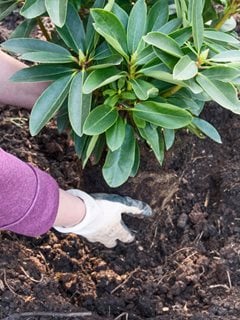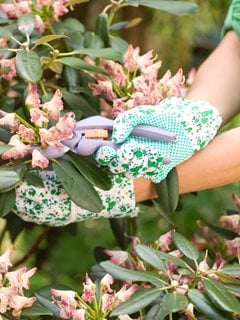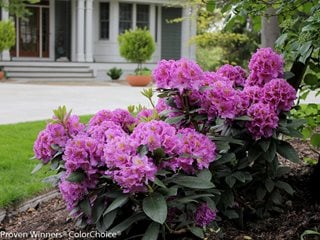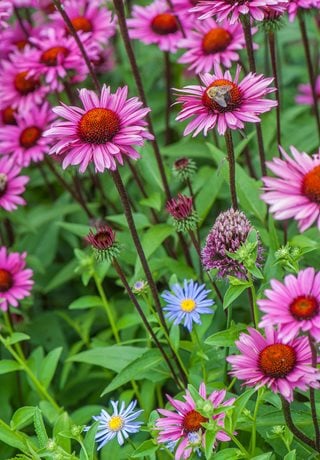Growing Rhododendron Bushes in Your Garden
Learn how to plant, prune and care for rhododendron plants Updated 2/8/2022Rhododendrons are acid-loving, woody shrubs with colorful flower clusters. They prefer damp climates with cool, mild temperatures, but there are rhododendron plants suitable for Zones 4-9. With thousands of varieties available, there's one to suit just about every garden.
This popular flowering shrub thrives in woodland settings with dappled shade and protection from hot afternoon sun. They can be used as hedging, screening, in foundation plantings, containers, mixed borders or mass plantings.
On this page: Basics | Types| Planting | Care | Varieties | Design Ideas | FAQ's | Where to See Rhododendrons
On this page:
- BASICS
- TYPES OF RHODODENDRONS
- PLANTING RHODODENDRONS
- RHODODENDRON CARE & MAINTENANCE
- RHODODENDRON PICTURES
- DESIGN IDEAS
- FREQUENTLY ASKED QUESTIONS
- WHERE TO SEE RHODODENDRONS
BASICS
Zones:
4-9; however, most varieties are hardy in Zones 5-8
Height/Spread:
Varies depending on species and cultivar; from the smallest variety at 18 inches tall and wide, to the largest species which can reach 100 feet tall.
When do rhododendrons bloom?
Peak bloom generally occurs in mid-spring; however, some bloom as early as March and others as late as July.
Rhododendron colors:
Colorful flower clusters, known as trusses, come in many hues: pink, white, reddish-purple, deep crimson, lavender-blue, apricot, orange, and yellow.
Exposure:
Plants do best in partial shade or dappled shade, especially those with large leaves. Tiny-leaved alpine and dwarf species are best in cool, bright light.
Climate:
The damp, mild climate of the Pacific Northwest is perfect for growing rhododendrons. Growing them in colder climates, especially in the Northeast, can be a challenge.
TYPES OF RHODODENDRONS
Rhododendron types:
There are eight different types of rhododendrons to choose from—some are tall like trees, others are more shrub-like.
The two main categories are:
- Elepidotes: meaning leaves without scales, includes azaleas
- Lepidotes: meaning leaves with scales
Rhododendron vs azalea:
Rhododendrons and azaleas are both classified in the genus Rhododendron, though they are differentiated by several characteristics:
- Rhododendrons are generally larger than azaleas.
- Rhododendrons are strictly evergreen, while azaleas may be deciduous or evergreen.
- Leaves of rhododendrons are thicker and often smoother, with azaleas having minute hairs on the tops of leaves.
- Azalea flowers typically have 5 to 6 stamens, while rhododendron flowers usually have 10 or more stamens.
- Azaleas have one flat or tubular or funnel-shaped flower per stem, whereas rhododendrons have bell-shaped flowers in trusses.
See more on how to grow azalea bushes.
PLANTING

Whether you live in a mild, cold or hot climate will determine what time of year is best for planting. Photo by: John Swithinbank / Alamy Stock Photo.
When to plant:
The American Rhododendron Society (ARS) recommends the following planting times based on your climate:
- Mild climates: Can be planted year-round
- Cold climates: Early spring planting is best, with early fall planting a good second choice
- Hot climates: Fall planting allows the plant's root system to establish during the cooler months
Where to plant:
In addition to filtered shade and good drainage, pick a spot with protection from the wind. The ARS recommends that you avoid planting them near concrete because it creates alkaline soil conditions that are detrimental to their development. Furthermore, don't plant rhododendrons near other surface roots that compete for space, water, and nutrients.
Soil:
Plants thrive in acidic soil (pH 6 and lower) that are light, well drained, and rich in organic matter. “They actually like to grow on top of the landscape, as opposed to deep in the ground,” says Jenkins Arboretum's Harold Sweetman. Amending the soil with organic matter such as leaf mulch or fine bark will help both the acidity and drainage.
Transplanting:
If your rhododendron has outgrown its spot, don’t worry, its shallow roots make for easy transplanting.
Planting tips:
- Water thoroughly before planting
- Loosen the roots before placing the plant in the ground to stimulate new root growth
- Position the crown of the root ball a few inches higher than the surrounding soil
- Space plants according to their mature size
- Avoid smothering the trunk with mulch
CARE

When deadheading, be careful not to remove the buds or shoots below the flower cluster. Photo by: Agencja FREE / Alamy Stock Photo.
Watering:
Due to their shallow, fine roots, rhododendrons require regular watering through dry periods. They will show signs of drought stress much sooner than plants with deeper roots. Keep the soil moist, but don’t let it become soggy.
Mulching:
Mulch with compost, bark chips, or pine needles to prevent weeds, since hoeing can easily damage the surface roots. Mulching also helps retain moisture. Replenish the mulch annually, or as needed.
Pruning:
Deadhead rhododendrons right after they finish blooming and be careful not to cut off next year’s buds, as they bloom on old wood.
Shape into a rhododendron tree to show off the sculptural trunk, or to give an arched or cascading effect.
Fertilizing:
Proper soil preparation before planting, along with regular mulching with organic material during the growing season means extra fertilizer is usually unnecessary.
If you think your soil is no longer up to par, apply a fertilizer designed for acid-loving plants in late winter or early spring. Since they are shallow-rooted, be extra careful when fertilizing so roots are not burned. The rootzone should be moist prior to application, the fertilizer watered in, and the area kept moist. Non-manure organic fertilizers are best.
If you’re having a specific problem, check out these recommendations from ARS.
Diseases & pests:
The best way to prevent damage to your plants is to make sure they are properly planted and well maintained.
Rhododendrons are susceptible to the following diseases:
- Branch die-back
- Phytophthora and Armillaria root rot
- Powdery mildew
- Gall
- Petal blight
The following insects can be a problem:
- Lace bug
- Weevils
- Thrips
- Rhododendron borer
- Spider mites
- Aphids
- Azalea caterpillar
- Leafminers
RHODODENDRON VARIETIES
DESIGN IDEAS
Here are a few tips for incorporating rhododendrons into your garden:
- Choose plants with staggered bloom times to guarantee a few months or more of splendid color.
- Rhododendrons make wonderful companions to other acid-loving plants and trees, such as ferns and flowering dogwoods.
- Many bulbs, like tulips, daffodils, and lily-of-the-valley, will bloom around the same time, without competing for water, nutrients, or space.
FREQUENTLY ASKED QUESTIONS
Are rhododendrons poisonous? According to the National Capital Poison Center, serious poisoning is unlikely when small pieces are eaten. However, life-threatening symptoms can occur when large amounts of these plants, or honey made from them, are consumed. The Center recommends watching children and pets closely when outdoors to prevent this from happening. See more Common Poisonous Plants for Dogs and Cats.
Why does my rhododendron have yellow leaves? Wherever soil tests neutral to alkaline (i.e., yielding a pH reading higher than 7), rhododendrons will be hard to grow. When the pH is too high, their leaves turn yellow. Try lowering your soil’s pH by top dressing with acidic mulches such as ground fir bark or pine needles, or use liquid chelate applied with a watering can around the rootzone.
Why do rhododendrons not flower? Failure to bloom is often caused by one of the following two factors: Cold weather kills their flower buds, or they aren’t getting enough light. Pick a variety that has been proven hardy in your area and plant it in an eastern exposure or one with dappled light and no hot direct sun.
Do deer eat rhododendron? Unfortunately, deer love rhododendron plants. Rutgers rates them as a C or D, occasionally to frequently severely damaged, depending on variety.
WHERE TO SEE RHODODENDRONS
Visit the following gardens to see them at their finest:
- The Rhododendron Species Foundation Botanical Garden, the world's largest collection, covers 22 acres in a conifer forest just south of Seattle. The garden boasts more than 600 of the 1,000-plus identified species.
- Crystal Springs Rhododendron Garden is just minutes from downtown Portland and contains an outstanding collection of rare species and hybrids. Explore the seven-acre garden during April and May when the plants are in full bloom.
- The annual Heritage Museums & Gardens Rhododendrons Festival in Cape Cod is a great place to see many varieties in bloom. Enjoy peaceful walks surrounded by majestic flowers and participate in activities with horticulture experts.
- Rhododendron State Park in Fitzwilliam, New Hampshire, features a 16-acre grove of Rhododendron maximum, which has a soft pink, almost white, flower and is the only elepidote species native to New England. Visit in July when the fragrant clusters of pink blossoms burst into bloom-immerse yourself in their perfume by following a trail that encircles the grove.
- Jenkins Arboretum & Gardens in Devon, Pennsylvania, features a diverse collection of over 5,000 rhododendrons from around the world. The first blooms begin in late March and the last end in late July.
RELATED:
Best Flowering Shrubs
The 24 Best Plants to Attract Hummingbirds
Shrubs for Shade
















